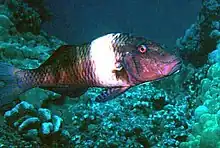Parupeneus multifasciatus
Parupeneus multifasciatus, the manybar goatfish, is a species of goatfish native to the eastern Indian Ocean Pacific Ocean where it is found from Christmas Island to the Hawaiian Islands and from southern Japan to Lord Howe Island.
| Parupeneus multifasciatus | |
|---|---|
 | |
| Scientific classification | |
| Domain: | Eukaryota |
| Kingdom: | Animalia |
| Phylum: | Chordata |
| Class: | Actinopterygii |
| Order: | Perciformes |
| Family: | Mullidae |
| Genus: | Parupeneus |
| Species: | P. multifasciatus |
| Binomial name | |
| Parupeneus multifasciatus | |
| Synonyms | |
| |
Its Hawaiian name is moano-nui-ka-lehua (meaning "great moano of the lehua"), and the juveniles are called 'ahua or 'ohua (meaning "seedling").[2] Moano in Hawaiian means pale-red color.[3]
Description
A recognizable feature of the goatfish is their chin whiskers. Some common features are yellow or blue accents on the edges of scales, dark spots around the eyes, dark spots around the base of the pectoral fin, and white and dark bars[3]. Some common color variations include: red with black spots; light red with no spots; black with yellow spot near the tail; and purple-red with yellow and black spots.[2] Males of this species can reach a length of 35 centimetres (14 in) TL while females only reach 17.9 centimetres (7.0 in) SL.[4] Their reproductive size is 7 inch (17.8 cm).[3] The heaviest recorded moano was 453 g (0.9987 lb).[4] The life history of the moano has a pelagic larval duration of 24 – 28 days in captivity.[5]
Ecology
Moano are common reef fish found in shallow water environments, reef flats, and outside reefs.[4][3] They spend a lot of their time in the benthic zone. They can be found at depths 0 – 161 m deep (0 – 528 ft).[5]
They are endemic in three regions: Hawaiʻi, Marquesas, and the Indo-Polynesian Province.[5]
Diet
They are diurnal consumers that prey on crustaceans and small fishes.[3] They can be omnivores.[4]
Fishing regulations
In Hawaiʻi, it is common to catch moano using nets / traps, spears, and pole/line[3]. In Hawaiʻi, the minimum size requirement is seven inches, and eight inches on the island of Maui.[3]
Human Uses
Moano are game fish that can be eaten raw, broiled, or baked.[2] This is a commercially important species, and can be found in the aquarium trade.[4]
References
- Curtis-Quick, J. (2017) [errata version of 2010 assessment]. "Parupeneus multifasciatus". IUCN Red List of Threatened Species. 2010: e.T154670A115220000. doi:10.2305/IUCN.UK.2010-4.RLTS.T154670A4602011.en. Retrieved 5 April 2020.
- Titcomb, Margaret (1977). Native use of fish in Hawaii. Mary Kawena Pukui (2nd ed.). Honolulu: University Press of Hawaii. ISBN 0-8248-0592-5. OCLC 10482126.
- "'Ike Kai". Department of Land and Natural Resources.
- Froese, Rainer; Pauly, Daniel (eds.) (2013). "Parupeneus multifasciatus" in FishBase. December 2013 version.
- Szabó, Zoltán; Snelgrove, Brent; Craig, Matthew T; Rocha, Luiz A; Bowen, Brian W (2014-01-01). "Phylogeography of the manybar goatfish, Parupeneus multifasciatus, reveals isolation of the Hawaiian Archipelago and a cryptic species in the Marquesas Islands". Bulletin of Marine Science. 90 (1): 493–512. doi:10.5343/bms.2013.1032.
External links
- Photos of Parupeneus multifasciatus on Sealife Collection
![]() Media related to Parupeneus multifasciatus at Wikimedia Commons
Media related to Parupeneus multifasciatus at Wikimedia Commons
